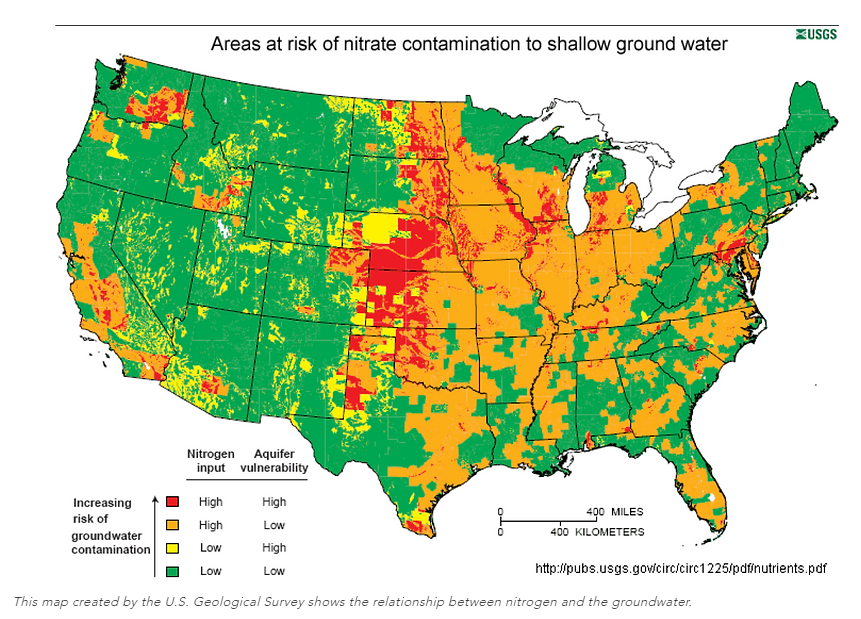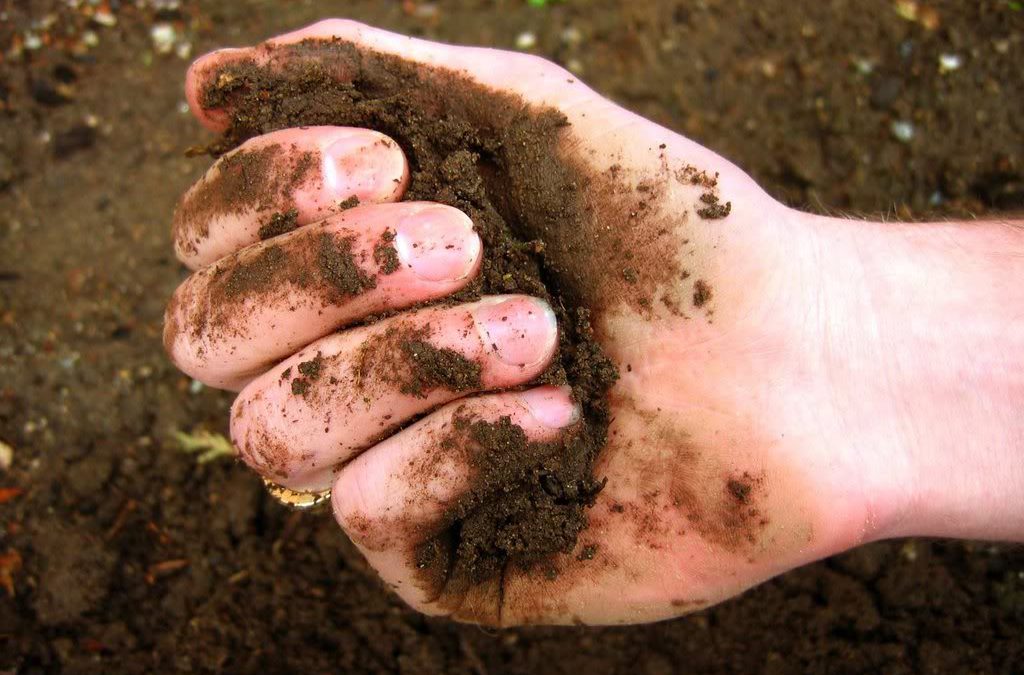Efficient use of water in commercial agriculture applications enabled by the GroGuru solution keeps fertilizer in the root zone of the crop, reducing Nitrate usage and leaching into the groundwater, and providing improved management capabilities for sustainable farming
Executive Summary
- Efficient use of water and fertilizer is good for the environment, reduces greenhouse gas emissions, reduces nitrates in the groundwater, and improves sustainable farming practices
- Active management of root growth in annual field crops and year around soil monitoring improves efficient use of fertilizer, reduces greenhouse gas emissions, reduces Nitrates in the groundwater, increases carbon sequestration in the soil, increases profitability of farmers, and increases the overall positive impact of sustainable farming practices
- Real-time measurement combined with Artificial Intelligence (AI) to determine soil water holding capacity, root growth, root depth and water penetration in soil
- Deeper roots enable better capture of fertilizer before it can leach into the groundwater
- Management of water percolation enables farmers to effectively operate without fully saturated soils that exacerbate Nitrate leaching into groundwater
- Permanently installed soil probes in annual field crops allow farmers to measure winter snow melt and soil temperature; manage preseason and full season irrigation, enables year-to-year comparisons to improve results with crop rotations, and more effectively manage cover crops
- Increase in fertilizer prices by nearly 3X over the last two years makes more efficient use of fertilizer even more important than ever for farmers
Water Management Matters
Water transports nutrients (i.e., fertilizer) and drainage takes nutrients below the root zone, so it is wasted and no longer accessible to the crop. Properly calibrated, permanently installed soil moisture probes enabled with Artificial Intelligence (AI) measure 1) how deep the root zone of the crop is; and 2) how deep water penetrates the soil. Proper use of soil moisture probes will promote deeper root growth which allows greater extraction of fertilizer before it has a chance to be leached below the root zone and into the groundwater (i.e., bigger root system = bigger net to catch nutrients).
Deeper roots also resist leaching as only excessive amounts of water will drain below the larger root zone. Proper use of soil moisture probes enables irrigators to operate without fully saturated soils (i.e., equivalent to watering potted plants and knowing you have done an excellent job but without seeing water coming out the bottom). Operating without fully saturated soils then allows rainfall to be caught in the soil rather than causing saturation and subsequent leaching.
A practical example of over-irrigation can be found in home maintenance and watering of potted plants. Most people can readily understand this example. Most home gardeners water potted plants until they see water coming out the bottom of the pot. However, by definition, they have over-watered and there is fertilizer and other soil nutrients in the drainage water. The impossible challenge for gardeners is to fill the pot exactly but without water coming out the bottom. Then throw into the mix that the plant water requirements change every day (with the weather) and every few weeks (with the amount of growth / plant growth stage). It is almost impossible to get this right without “seeing into the soil” and highlighting the power of soil moisture sensors.
Another analogy of the value of the proper use of soil moisture sensors would be to challenge people to drive from NY to CA without a gas gauge. The chances are that they will fill up their gas tank more than they need, or they may run out of fuel more than once. To get this right, people would need to constantly calculate mileage and then adjust that for hills and headwinds/tailwinds (i.e., an almost impossible task); or they could just use a gas gauge. Soil moisture probes are like gas gauges for crops and the A.I. works like the trip computer.
Positive Economic Impact of Fertilizer Usage Through Efficient Irrigation Practices
Nitrogen fertilizer leaching out of the root zone not only represents a direct loss but there is also an opportunity cost of reduced yield because the crop can no longer access that fertilizer. Crop budgets in the TX panhandle show fertilizer accounts for roughly 25% of the growing cost for corn. A modest 5% saving of fertilizer through better irrigation management, represents $9/acre and by putting that fertilizer through the plant, we could get a yield increase of 5-10% which represents $72-$144/acre; and would go straight to the farmers’ bottom line. The cost of nitrogen fertilizer has increased almost 3X in the last two years and farmers can no longer afford to waste it. (Source: https://www.dtnpf.com/agriculture/web/ag/news/article/2021/12/15/high-fertilizer-prices-history). Saving fertilizer through better irrigation management and reduced leaching is a win-win-win. It saves money, increases returns and improves the environment.
In eastern Nebraska for example, experience has shown that farmers typically over irrigate 4″ per season and ¾ of this is in the early part of the season when soils are wet and crop demand is small. According to the University of Nebraska, farmers have an average loss of ~10lbs per inch of excess water, so this over irrigation costs approximately 30lbs of nitrogen (N) and much of it ends up in the groundwater. When you consider that the current cost of N is $1.09 /lb. for Urea Ammonium Nitrate (UAN) 32% solution so 30lbs = $32.70/ac wasted fertilizer. Add in the cost to apply 1″ of irrigation is $6.15 so 3″ wasted irrigation = $18.45/ac wasted pumping cost. The loss of yield at 1.16 bushels per pound of N = 34.8 bushels; @$6 /lb. = $208.80/acre opportunity cost in yield assuming that the fertilizer was not replaced. Just take the straight losses and the economic impact is >$50/acre in losses due to over irrigation. To run your own calculations, Texas A&M University provides a simple calculator: https://soiltesting.tamu.edu/NCalculator/Ncost.htm
Case Study – Hasta Farms Use of Deficit Irrigation in the Texas Panhandle
“Use of moisture probes is a critical part of our operation, as water is our most limited resource. GroGuru has introduced the first permanent probe,” said Harold Grall, Owner of Hasta Farms. “The probe tells me moisture levels at various depths, which is critical to know during key points in the growing season. Use of the GroGuru system has taken my yield from 230 bushels per acre to 250 bushels per acre, an increase of 20 bushels per acre. At $5 per bushel, that is $100 more per acre. GroGuru is much better than the GroGuru competitive alternative system we used before.”
The value of irrigation scheduling in the Texas Panhandle has been shown to be in the order of $60-$100 per acre per year, based on a broader study by the North Plains Water Conservation District. This is due to yield increases of ~20 bushels per acre of corn at $3-5 per bushel. However, with today’s prices this represents closer to $120/acre. Much of this increase is due to getting the timing of early and late season irrigations correct and running the pivot at the correct speed to get the right depth of water penetration. The ability to observe winter moisture and perform accurate pre-season irrigation is critical and was not available prior to the advent of permanently installed probes. Deep soil moisture is critical in growing high yielding crops in this environment and the ability to fill the profile and manage the process in a precise manner reduces production risk for farmers in that region.
Sustainable Agriculture Practices Benefit from the GroGuru Year Around Monitoring
Cover crops and regenerative farming have been shown to add huge environmental benefits and can add to carbon sequestration. However, many farmers are reluctant to grow winter cover crops as they think that it will take stored soil moisture away from summer crops. However, using permanently installed soil moisture probes allows farmers to measure the benefits of cover crops and to terminate them (kill them with herbicide) when they see them start to take too much stored soil moisture. This allows farmers to manage cover crops in a very precise way and not reduce stored soil moisture availability for summer crops like corn and cotton.
Farmers usually apply some fertilizer through the irrigation system in a practice called fertigation, where the fertilizer is dissolved in the irrigation water. So, if you are not measuring soil moisture and wetting fronts, you are not managing where the fertilizer goes, and you do not know how well you are using the fertilizer applied. You cannot manage what you do not measure.
Most farmers of high value tree and nut crops use quite a lot of fertilizer, and they apply most of it through their irrigation systems. However, the customary practice is to run the system first (i.e., typically for many hours) to wet the soil first and then apply the fertilizer at the end of the irrigation cycle. However, what they do not realize is that water sticks to the surface of soil particles and if water is applied on the soil surface, the soil wets up from the top down. So, the first irrigation water wets the top layer, then water runs through the wet soil to the layer beneath. Then more water runs through those layers to the dry layers beneath and so on. So, if the fertilizer is applied last, then it is taken the deepest and this is to the bottom or past the bottom of the root zone. Using soil moisture probes, farmers can know how deep the water is penetrating and apply fertilizer to precise levels within the root zone.
The well understood example of this is to wet a potted plant until water comes out the bottom. Then stop to let it all drain and then start watering again but this time with red dye in the watering can. Water will start to drain almost immediately, and it will be red as there is no dry soil for the red water (i.e., fertilizer) to stick to. Many of GroGuru’s customers have experienced efficiency improvements in fertigation with use of the GroGuru system.
Reduced Nitrate Leaching and Other Environmental Benefits
The use of fertilizer to deliver increased crop yields, and delivering a particularly good return on investment, has been significantly studied and validated. Nitrogen is the most used fertilizer, and it is also the most mobile of any type of fertilizer (i.e., it moves through the soil very readily compared to potassium and phosphates). As a result of this ease of migration, it is common for farmers to use more than they would optimally need, because they know it is hard to keep in place.
Most farmers also know the benefits of having abundant water available to the crops and most use the principle that “some is good, but more is better” so they overwater their crops. They typically think that the risk of underwatering is far greater than the risk of overwatering. However, overwatering causes drainage and drainage causes leaching of fertilizers, especially those that migrate easily through soil, and other nutrients in the soil into the groundwater supply
The higher value row crops such as corn and potatoes tend to get more fertilizer as they show the biggest return on investment for fertilizer use. Developing a robust root zone is essential for corn growing, however potatoes are shallow rooted, so they present a different challenge when trying to hold fertilizer in the root zone. Recall that deeper root growth allows greater extraction of fertilizer before it has a chance to be leached (i.e., bigger root system = bigger net to catch nutrients). So, potato production brings in a new set of challenges, especially since they are predominantly grown on sandy soils that are easily drained. This makes it extremely easy to wash fertilizer below the root zone of the crop and soil moisture probes are a critical tool when it comes to spoon feeding water and nutrients to the crop. It also comes as no surprise that the areas with the highest rate of nitrates in the ground water are in eastern Nebraska and Wisconsin with high rainfall, sandy soils, and high value crop production.
Nitrates in the ground water present health risks, which can be severe when nitrates in drinking water exceed 10ppm (parts per million). These include fertility issues, birth defects and a range of cancers. Nitrates in rivers and lakes also cause algal blooms that kill wildlife and release toxins into drinking water.
70% of Wisconsin residents get their drinking water from groundwater. Nitrate is the largest contaminant of groundwater and 90% of the nitrates in groundwater are due to agriculture (i.e., over fertilization and leaching). In 2018, approximately 7% of all groundwater samples tested in Wisconsin were above the safe limit. Many counties had >20% of samples above the safe limit. The cause of this contamination is due to fertilizer leaching and the most irrigated areas are some of the worst affected. Farmers in these regions could benefit from soil moisture probes and GroGuru is now working with McCain Foods on a project to educate potato farmers on how to reduce leaching in the central sands area of Wisconsin. Eastern Nebraska has a similar issue with nitrates in the groundwater and the advice in a 2015 document from the University of Nebraska on Irrigation and Nitrogen Management cites soil moisture sensors as a key component of reducing nitrate leaching (Source: https://extensionpubs.unl.edu/publication/9000018117876/irrigation-and-nitrogen-management/).
Only 5% of farmland in Wisconsin is irrigated, so it is important not to overstate irrigation’s contribution (Source: https://dnr.wisconsin.gov/newsroom/release/47586). Indeed, many of the best farming areas around the Midwest rely solely on rainfall but these are heavier silt loam soils. As such, the soil is not freely drained and much of this land has tile drains laid under farm fields to remove excess moisture from melting snow and spring rains. While this drainage might be manufactured, the threat of fertilizer leaching remains the same and since they drain into creeks and rivers, they represent a potentially large source of nitrates entering the environment (and into drinking water). Gating the tile drains and holding the water back in a managed way, can alleviate these losses and hold nitrates in the soil where it can be of benefit to the crop. Permanent soil probes can be a vital tool in managing the gate structures to better manage drainage and nitrate losses.
See map below and attached for areas at risk of nitrate leaching.

Summary
Efficient use of water and fertilizer is good for the environment, reduces greenhouse gas emissions, reduces nitrates in the groundwater, and improves sustainable farming practices. Active management of root growth in annual field crops and year around soil monitoring improves efficient use of fertilizer, reduces greenhouse gas emissions, reduces Nitrates in the groundwater, increases carbon sequestration in the soil, increases profitability of farmers, and increases the overall positive impact of sustainable farming practices.
Real-time measurement combined with Artificial Intelligence (AI) to determine soil type, root growth, root depth and water penetration in soil. Deeper roots enable the resistance of fertilizer leaching into the groundwater. Management of water percolation enables farmers to effectively operate without fully saturated soils that exacerbate Nitrate leaching into groundwater.
Permanently installed soil probes in annual field crops allow farmers to measure winter snow melt and soil temperature, manage preseason and full season irrigation. Permanent soil moisture probes also enable year-to-year comparisons to learn from one season and carry it forward improving results with crop rotations, and more effectively managing cover crops.
The increase in fertilizer prices by nearly 3X over the last two years makes more efficient use of fertilizer even more important than ever for farmers.

